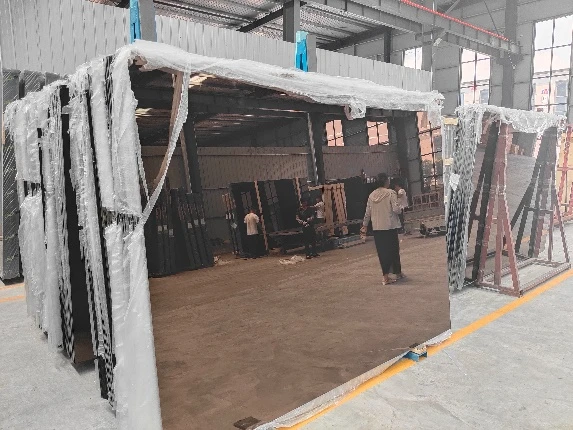Dec . 14, 2024 02:47 Back to list
Trends and Insights into Coated Glass Pricing in Today's Market
The Price Dynamics of Coated Glass An In-depth Analysis
Coated glass has emerged as a pivotal material in various industries, including architecture, automotive, and solar energy, due to its enhanced properties such as improved energy efficiency, UV protection, and aesthetic appeal. However, the pricing of coated glass can be influenced by numerous factors, making it a variable but vital component in construction and manufacturing costs. This article aims to explore the various dynamics affecting the price of coated glass, alongside the trends and forecasts for this burgeoning market.
Understanding Coated Glass
Coated glass refers to glass surfaces that have been treated with a protective or decorative coating. These coatings can serve many functions, including reflecting sunlight, improving thermal insulation, increasing durability, and enhancing visual appeal. The most common types of coatings include low-emissivity (Low-E), reflective coatings, and anti-reflective coatings, each designed for specific applications. For instance, Low-E coatings are particularly favored in energy-efficient buildings, as they help to reduce heat loss during colder months and reflect unwanted heat during summer.
Factors Influencing Prices
1. Raw Material Costs The cost of the raw materials used to produce glass, such as silica, soda ash, and limestone, significantly impacts the overall price. Fluctuations in the availability and pricing of these materials can lead to volatile coated glass prices.
2. Manufacturing Processes The production of coated glass involves advanced technologies, which can include vacuum deposition and magnetron sputtering. These processes require substantial energy and investment in specialized equipment. The complexity and cost of the manufacturing techniques directly influence the final prices of coated glass products.
3. Market Demand With the growing emphasis on sustainability and energy efficiency in construction, demand for coated glass is on the rise. Increased interest from the commercial, residential, and automotive sectors can lead to higher prices, particularly if supply does not keep pace with demand.
4. Regulatory Standards Stricter regulations regarding energy efficiency and environmental impact can affect the production process and costs. Manufacturers may need to invest in new technologies or process improvements to comply, thereby influencing pricing structures.
coated glass price

5. Geopolitical Factors Global trade dynamics and geopolitical tensions can impact the supply chain, particularly for countries that rely heavily on imported materials. Trade tariffs and restrictions could further add to production costs, thereby affecting the price of coated glass.
Current Trends
The coated glass market is witnessing several noteworthy trends
- Increasing Adoption of Energy-efficient Solutions As building codes become more focused on energy efficiency, the adoption of coated glass is expected to rise. This trend will likely lead to a surge in demand, putting upward pressure on pricing.
- Technological Innovations Advances in coating technology are creating new opportunities for manufacturers to produce more efficient and cost-effective products. Innovations such as self-cleaning surfaces and enhanced durability coatings are gaining traction and could change the price dynamics in the long run.
- Sustainable Practices With a growing emphasis on sustainable building materials, manufacturers are pressured to employ eco-friendlier production methods. While this transition may initially raise costs, it is likely to lead to long-term price stability as demand for sustainably produced coated glass grows.
Future Outlook
Looking ahead, the coated glass market is poised for growth, fueled by urbanization, infrastructural development, and the increasing focus on sustainability. Industry analysts forecast that prices may stabilize due to advancements in manufacturing technologies and the introduction of more cost-effective raw materials. However, unpredictable external factors, such as global supply chain disruptions and raw material price volatility, could continue to influence the pricing landscape.
In conclusion, the price of coated glass is shaped by a confluence of factors ranging from material costs and manufacturing processes to market demand and regulatory frameworks. As industries increasingly prioritize energy efficiency and sustainability, the coated glass market is expected to grow. Understanding these dynamics is crucial for stakeholders, including manufacturers, builders, and consumers, to navigate the complex landscape of coated glass pricing effectively. As innovations continue to emerge, the coated glass industry may find itself at the forefront of a green building revolution, balancing cost with ecological responsibility.
-
Safety and Style with Premium Laminated Glass Solutions
NewsJun.24,2025
-
Reinvents Security with Premium Wired Glass
NewsJun.24,2025
-
Premium Float Glass Line for Modern Architecture
NewsJun.24,2025
-
Low Emissivity Glass for Energy-Efficient Architecture
NewsJun.24,2025
-
High-Performance Insulated Glass Solutions for Modern Architecture
NewsJun.24,2025
-
Elevates Interior Style with Premium Silver Mirror
NewsJun.24,2025
Related PRODUCTS














